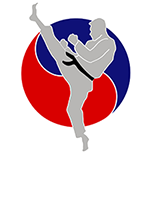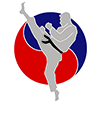-
- What is the significance of bowing?
- What are the differences between styles of martial arts and what style do you teach?
- How many times per week should I or my child attend classes?
- What about sparring and tournaments? Are they required?
- How long will it take to get a black belt?
- How often are rank advancements?
- What standards do you teach at Omega?
- What are the Tenets of Taekwondo?
- How do you pick students for your demo team?
- What Korean terms are frequently used in classes?
- How do I enter or leave the studio (dojang) and classes?
- What to do if a student is late for class?
Q: What is the significance of bowing?
Martial arts is built upon the concept of respect and discipline. Bowing is a way to continually show this respect. Omega students show their respect by bowing to the flags when entering the dojang, bowing towards instructors and fellow students as well as bowing to enter or exit the workout floor.
Q: What are the differences between styles of martial arts and what style do you teach?
Omega Martial Arts teaches the Omega Tao which comprises several different styles of martial arts, including Taekwondo, Hapkido, Jiu Jitsu, Okinawan Weaponry and more. To learn more about the styles we teach please visit the About the Arts page for details. Omega does not teach karate or kungfu or other Chinese arts, we focus mainly on the Korean arts.
Q: How many times per week should I or my child attend classes?
We prefer students to attend classes at least two times per week.
Q: What about sparring and tournaments? Are they required?
Sparring classes are held at least once a week and all students beginning with white belt are required to spar as part of their martial art training. Students green belt and above are required to compete in at least one tournament per year.
Q: How long will it take to get a black belt?
Achieving the Omega black belt is a very individual accomplishment. It varies greatly on the students natural ability, the amount of practice at home and in the dojang, the heart of the student and more. The typical timeline to gain an Omega black belt is between four and five years.
Q: How often are rank advancements?
We hold rank advancements once a month. Test locations rotate between all our schools. Typically your home school test are held once every three months. Students may attend rank advancements at any school with their head instructor’s permission.
Q: What standards do you teach at Omega?
The Omega Student Creed
1. I will avoid anything that could harm my mind or body.
2. I will practice honesty and integrity in all my doings.
3. I will show respect to my instructors, my parents and my Dojang.
4. I will always honor my word and my commitments.
5. I will use Martial Arts for defense only.
Q: What are the Tenets of Taekwondo?
COURTESY ~ HUMILITY ~ INTEGRITY ~ PERSEVERANCE ~ SELF CONTROL ~ INDOMITABLE SPIRIT
Q: How do you pick students for your demo team?
Try-outs are required to be on the Omega demo teams. Several factors are taken into consideration when selecting a student to be on this team, including accomplishments, dedication, commitment to the art, commitment to the school, technique, ability, energy and more.
Q: What Korean terms are frequently used in classes?
Titles
- Student Instructor – Hak Saeng
- Junior Black Belt Instructor – Cho Kya Nim
- Black Belt Instructor – Sah Bum Nim
- Chief Black Belt Intructor – Chung Sah Nim
- Head Black Belt Instructor of School – Kwan Jang Nim
- Master Black Belt Instructor – Shihan
Commands
|
Counting
|
Ending Class Salutation
- Always Do Your Very Best – Hang Sung Soo Go
Q: How do I enter or leave the studio (dojang) and classes?
When a student enters and leaves the studio (dojang), he/she is required to turn and face the three flags at the front of the room and bow. Bowing is a traditional way of showing respect to someone or something. We bow the American, the Korean, and the Japanese flags to show respect toward the countries which have provided us with our martial arts.
When a student is comes onto and leaves the exercise floor, he/she is required to bow as well. This show respect toward the students, the instructors, and it is a reminder to the individual student to leave everything out on the practice floor; to give 100% while in class.
Q: What to do if a student is late for class?
If a student is late for class, once the student is dressed in his/her uniform and belt (dobok and dhee), the student will bow when coming on to the exercise floor, they will approach the class from the left side of the room and stand in ready stance (jhoon-bi) until the instructor recognizes him/her. Once the instructor faces the student, the student will ask “Permission to enter class?” The instructor will bow and direct the student as to where he/she needs to line up.

